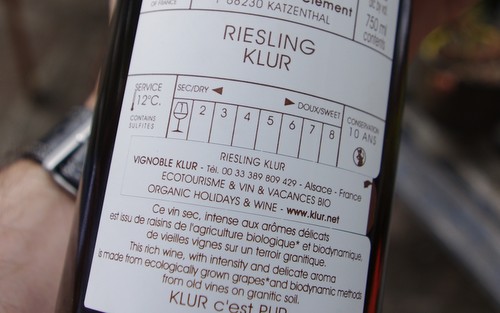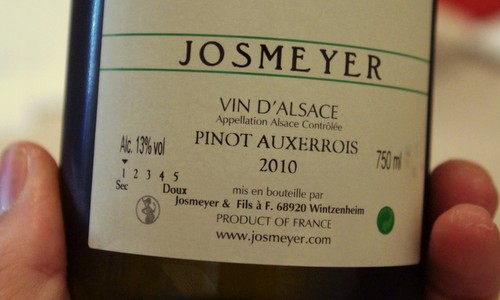
I love Alsace wines. More so for just having come back from this most beautiful of wine regions. When can I visit again? I want to plan another trip.
One of the issues of Alsace wines is that of sweetness. Unless you are seriously knowledgable, you just don’t know whether you are going to be opening something sweet, off-dry, sweetly fruited, or bone dry. It depends on the producer’s style, the vineyard, and also the vintage.
As a result, many Alsace bottles now have a sweetness scale on the back label. This is a good thing, but only to the extent that it actually works in practice.
One of the problems is the EU labelling regulations, which allow for the designation of four levels of sweetness (see here and also explained in more detail here). This is insufficient for the discrimination among the different styles of Alsace white wines.

The other problem is attempts to devise a sweetness scale with too much influence of wine analytical data. Yesterday in the Hengst Grand Cru vineyard in Alsace, Christophe Ehrhart of Josmeyer outlined his Expression Indices for Alsace Grand Cru wines. The scale runs from 1 to 5, and it’s pretty good, but the fatal flaw is that it relies on analytic data for residual sugar.
This means that it doesn’t work in practice. This is because sweetness isn’t just about the sugar. Christophe, of course, knows this, and point 1 in the scale bears acidity in mind. This is because acidity mitigates the sensation of sweetness, which is why Brut Champagne can taste dry at 10 g/litre residual sugar.
It is further down the scale, where simply sugar is taken into account, that it loses its way. Sweetness depends on acidity, sugar levels, alcohol levels (alcohol tastes sweet), fruitiness (fruity aromatics give an impression of sweetness), and even dry extract. We tried some wines at level 2 that tasted considerably sweeter than those at level 3.
If a sweetness scale is to work, it has to be done by sensory analysis, ignoring analytic data. This is the only way for it to be useful to consumers. Taste the wine. How sweet does it taste? Simple.
There’s also the way that sweetness changes with age. Alsace wines can, with age, ‘eat’ the sugar, and become more savoury. This is a complicating factor. Still, I think that all Alsace wines should have a sweetness scale on them, and I think the best way to do this is to get a number of tasters to taste the wine, and score it on a visual analogue scale – one where they have a line with dry at one end and sweet at the other, and they mark on this line where they think the wine sits.
5 Comments on On sweetness
Are you familiar with the International Riesling Foundation’s sweetness scale? I’d be interested in your thoughts on it. It uses acid levels in the calculation.
http://drinkriesling.com/tastescale
http://drinkriesling.com/tastescale/thescale
Someone on twitter pointed out this initiative for Australian Pinot Gris:
http://pinotg.com.au/
I disagree. I think an analytic scale is the only one that can work, much the same way IBUs are used to signify bitterness in beer.
There already is a scale , Brix.
Thats basically the old way of describing the sweetness of the wine. If you consider the fact that the EU regulations lets you label a highly acidic, wine with 7-8 grams of Acid / l as dry, as long the residual sugar is 2 grams less than the acid.